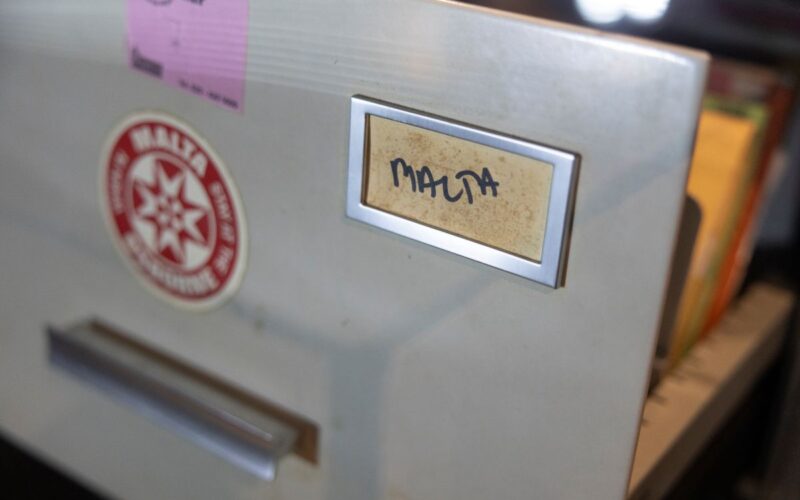In 2024, the family of the late Jeremy Boissevain (1928-2015) approached Heritage Malta with the wish that his archive, containing most of his research related to Malta, would be accepted into the National Collection. This was, of course, an opportunity that could not be missed. A filing cabinet and 18 other boxes made their way to Malta from Amsterdam with the help of his wife, Inga, and his daughters, Ieneke, Lietje, Maria and Anna. Their new home is the Inquisitor’s Palace in Birgu, which has served as the headquarters for the Ethnography Section since 1992.
A year later, this prompted the need for a small exhibition titled Legacy of an anthropologist: The Jeremy Fergus Boissevain Archive, which is being held in the Palace until the end of September. The exhibition serves as both a commemoration, remembering 10 years from Jeremy Boissevain’s passing, and to announce that this precious archive has returned to our shores.
The fact that Jeremy Boissevain always seemed to be working anywhere but in his own native country made him an outsider to many, no less to himself. From this archive, the reader can elicit his process as he tries to find his way around Malta, navigating not only the physical fabric of the island but the invisible web of local government. Following every string of woven silk, trying to find in whose limbs lies the loose end. From his time in Malta, his love and interest for this place deepened and became personal.

The archive contains various media of study, covering his early years in the 1950s and 1960s, sending out letters trying to locate the right university and, later on, the process of writing his doctoral thesis. In some of his books, especially the fieldwork edition of ‘A Village in Malta’ and later the 2006 publication of ‘Hal Kirkop: A Village in Malta’, Boissevain makes clear references to his methods of research. These, I am happy to say, are represented well in sections of the archive, although it’s doubtful that everything is still intact. The following periods of his life, mainly the 70s and 90s, are also accounted for. His years at the University of Malta are verified by several lecture notes and some of his students’ assignments. The other major part of this body of work, however, was what strangely piqued my interest.
Anyone who has delved into an archive for whatever reason can attest to the excitement of finding unfamiliar fragments of the past that help us understand how societies before us functioned. How they entertained, ran their governments, and built economies. Researching Jeremy’s archive reads differently. The titles of the files draw you in, seemingly familiar. Inside the files, countless newspaper cuttings with headlines which, were it not for the questionable print designs and fashion choices of the people pictured, you would mistake for yesterday’s news.
The closest thing many will find in a historical archive that could be considered relatable is often people’s lamentations about their situation or the behaviour of their perfidious neighbours, something which social historians lap up, but for it to feel more like a warning to a current situation is often not the case. Jeremy wrote his magnum opus, the book ‘Friends of Friends’, in 1974. The details of this publication are still very much in play, and although it was a resounding success, he continued to take an interest in local politics and Malta’s development well into the 90s and early 2000s, never one to rest on his laurels.
To give an example: the issues with the tourism industry, a subject that is ever-present in parts of this archive. Keep in mind that he saw this topic of discussion in its very infancy, right after the war, and the economic diversification efforts made by the government. At the time, it seemed to be an unregulated industry, which saw a boom in construction and an influx of visitors, leading to a buildup of waste and an almost incessant power and water management issue. At the same time, parcels of government land were leased or sold to firms for development, aiming to boost Malta’s reputation as a tourism destination. One does not have to look too deeply into the archive to come across these folders; simply open the first cabinet drawer and see reality repeat itself decades later.
An archive has a traceable beginning and often an end date. Due to the personal nature of this archive, it is hard to pinpoint and say with accuracy the right dates, which also made it a challenge to understand what system of filing and organization he was using. The recycling of folders also made it tricky to guess what was inside, as the names often don’t match the content. This, however, does not diminish the importance of their composition. A truly physical effort of one man, who came to join our community by chance but made it a point to create a legacy through his outspoken values and resolution to find logic where others refused.
With the archive now under the curatorship of Heritage Malta, it will be made available to the public and added to other similar works, like those of Guido Lanfranco. Efforts like the ones shown in the exhibition will result in further studies, especially through methods of oral history, to give the endeavours of these great researchers the longevity they deserve.
By Dylan Cachia
Junior Professional Officer (Curatorial) – Ethnography Section, Inquisitor’s Palace
Excerpts from Jeremy Fergus Boissevain’s archive are currently on display in an exhibition titled ‘Legacy of an Anthropologist: The Jeremy Fergus Boissevain Archive’, open to anyone visiting the Inquisitor’s Palace in Birgu until the end of September 2025, including interviews with family and colleagues of the late anthropologist.










